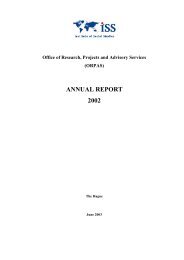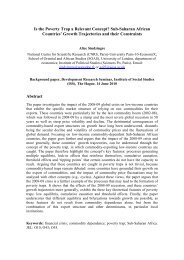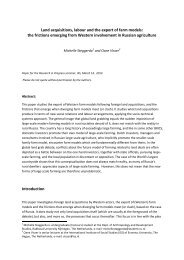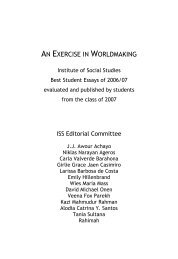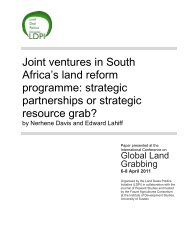AN EXERCISE IN WORLDMAKING 2009 - ISS
AN EXERCISE IN WORLDMAKING 2009 - ISS
AN EXERCISE IN WORLDMAKING 2009 - ISS
Create successful ePaper yourself
Turn your PDF publications into a flip-book with our unique Google optimized e-Paper software.
16 What’s Yours is Mine 183<br />
Special Report: A Life Revealed, featured in National Geographic’s<br />
(NatGeo) April 2002 edition.<br />
Situating Myself<br />
I remember, as a young girl, the day I turned the NatGeo page and saw<br />
the famous photograph popularly termed ‘Afghan Girl.’ I cut out the<br />
arresting photo and hung it on my wall, where it remained until I moved<br />
away. I was just one girl, ignorant of the Soviet invasion of Afghanistan<br />
and the impact on Afghani people: attaching my own specific meaning to<br />
the photograph. The act of cutting out her picture and looking at it for<br />
years, however, is where the analysis of ownership and objectification<br />
begins. The ‘Afghan Girl’ was utilized to operate within a storyline representing<br />
specific Afghani refugee populations to the West, and commercialised<br />
to sell everything from calendars to coasters. The character<br />
Chacko from God of Small Things articulated imperialism as, ‘What’s<br />
yours is mine, and what is mine is mine also’ (Roy 1997:57). This verbalization<br />
expresses the problematic role of media as a holder of representations<br />
along with media-consumers’ ownership of publicised images and<br />
experiences. Only later in life did the historical role of images, articles<br />
and particularly the function of NatGeo as an ‘educational source’ for<br />
developing ideology in Western adults and youth become clear. I situate<br />
myself in this essay as a participant in this Western ideology; Iranian-<br />
American raised in the Netherlands, sitting in my middle-class apartment<br />
bedroom gazing at the green eyes of the ‘Afghan Girl,’ allocating my interpretations<br />
of her reality and feelings to a photograph – a photograph<br />
that now, as a graduate student, I am critiquing through a reflexive process.<br />
Interest in Piece<br />
Johnstone’s exploration of the function of narration (‘talking about the<br />
past is apparently something all humans do’) was elaborated by Rosen’s<br />
‘autobiographical impulse’ – the ‘urge to make our lives coherent by telling<br />
about them’ (Johnstone 2001:640-1). Linde further expands their<br />
ideas: ‘In order to exist in the social world with a comfortable sense of<br />
being a good, socially proper, and stable person, an individual needs to<br />
have a coherent, acceptable and constantly revised life-story’ (ibid). If<br />
stories are living and changing as products of social life, what then is the<br />
power of discourse in arresting development? Examining NatGeo’s role




